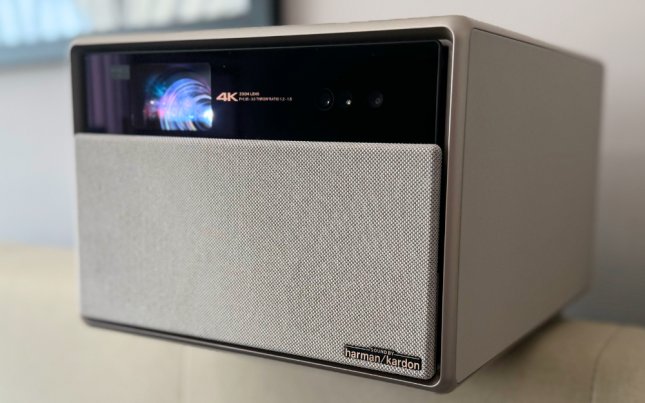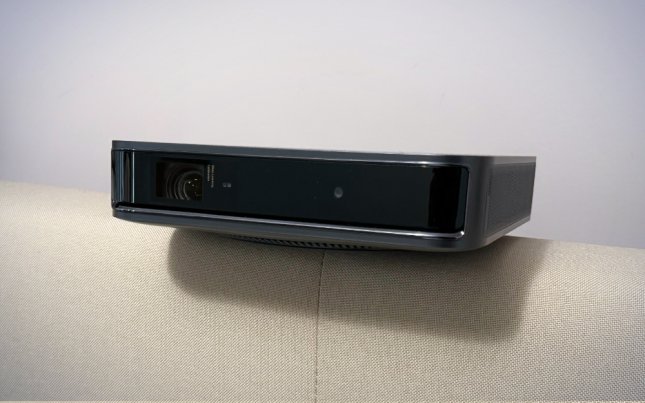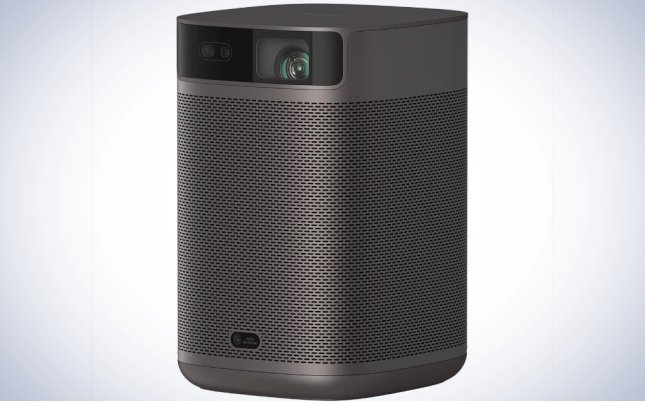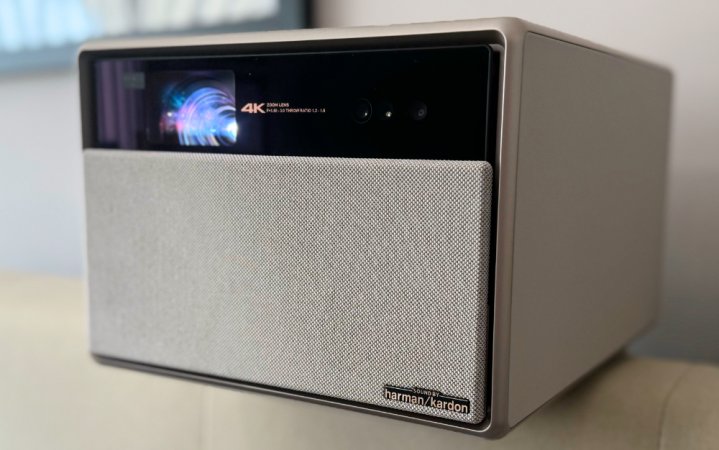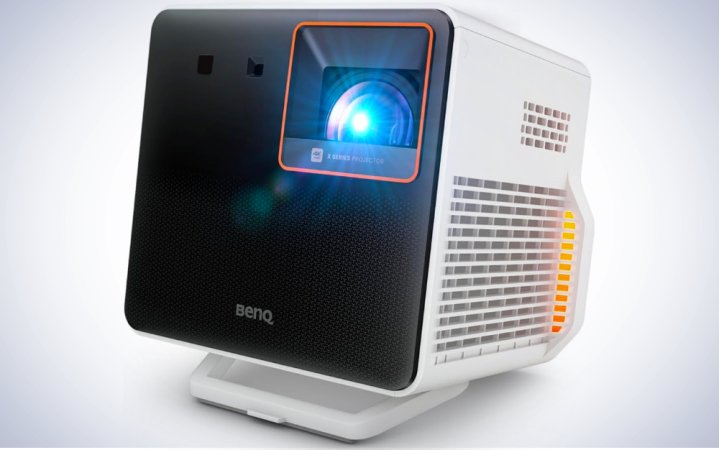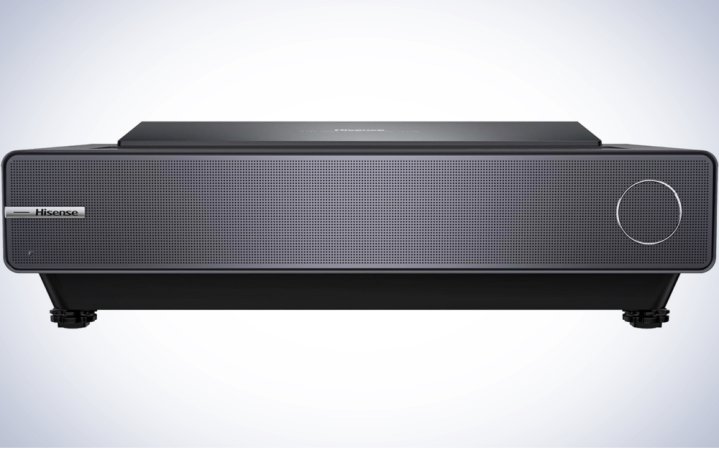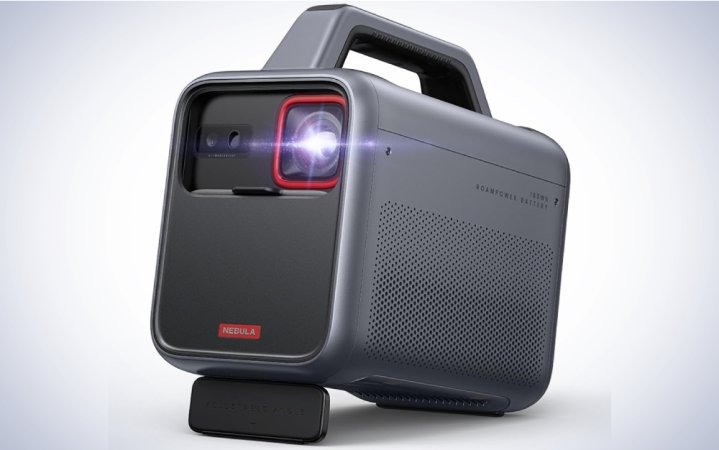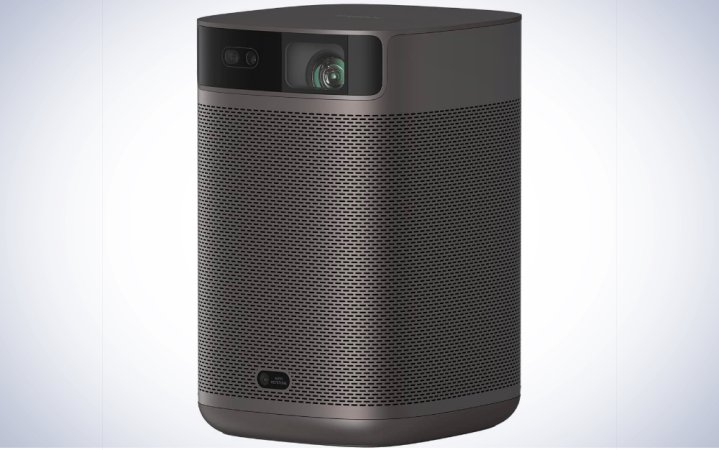We may earn revenue from the products available on this page and participate in affiliate programs. Learn more ›

Whether you’re more into the frenetic gunplay of Call of Duty or the slow charms of Stardew Valley, the idea of playing your favorite games on a 20-foot-tall screen is undoubtedly appealing, and projectors for gaming can make it happen. Though projectors were considered a generally weak option for gaming in the past, improvements in resolution and response time have dramatically increased their appeal to everyday consumers. The top-of-the-line projectors are still going to make a major dent in your wallet, but there are good budget options, too. While a 4K TV or monitor is the traditional choice for most gamers, there’s no better pair in the AV world than a projector with games. We looked at dozens of projectors to determine the best projectors for gaming in your specific setup, and here are our top picks.
- Best overall: XGIMI Horizon Ultra
- Best 4K: BenQ X300G
- Best portable: Nebula Mars 3
- Best short-throw: Hisense PX2-PRO
- Best mini: Dangbei Atom
- Best budget: XGIMI MoGo 2 Pro
How we chose the best projectors for gaming
I’ve been a professional tech writer for about a decade now, as well as a contributor to PopSci writing about everything from 3-D printers to VPNs. I know my way around gadgets for every level of consumer, from entry-level to industrial. To make these recommendations, I consulted personal testimonials, peer recommendations, consumer reviews, and tests conducted by top-quality professionals. This helped me to determine which projectors shone brightest.
The best projectors for gaming: Reviews & Recommendations
As you’ll see in our list, some projectors are so portable that you can take them on a road trip, or perhaps even on a plane. They’re also more outdoor-friendly than traditional TVs, so you can have a backyard grill or bonfire as you play games with your friends.
Best overall: XGIMI Horizon Ultra
Best overall
Pros
- 4K support
- Excellent color reproduction
- Solid speaker system
Cons
- Two HDMI ports
Why it made the cut: The XGIMI Horizon Ultra is a reasonably priced projector that delivers everything that a gamer could ask for.
Specs
- Price: $1,600
- Throw ratio: 1.2 to 1.5:1
- Brightness: 2300 lumens
- Resolution: 4K
- Response time: 18ms (4K)
- Refresh rate: 60Hz (4K)
- Other features: Dolby Vision support
- Screen size range: 40 to 200 inches
- Source lifespan: 25,000 hours
We chose XGIMI’s Horizon Ultra as the best 4K projector you can get in 2024, and stand by that recommendation if you’d like to use it primarily for gaming. Everything from its premium metal remote (surprisingly more high-quality feeling than plastic) to its industrial design, to overall perfromance is a slam dunk. We played Nintendo Switch games on this projector during our tests and were consistently impressed with its color accuracy, response time, and overall fidelity. Any missed frames were on account of the game, not this hardware. The Horizon Ultra allowed us to fully appreciate the candy-colored Penny’s Big Breakaway and Star Ocean: Second Story R especially. Gamers who play on the Xbox Series X or PlayStation 5 will appreciate the fact that this projector supports Dolby Vision, the latest HDR (High Dynamic Range) video standard. Games that support HDR have even deeper colors, and the Horizon Ultra will allow you to see every one.
One of this projector’s most surprising features is its relatively robust stereo speaker system, which was developed by Harman Kardon. The speakers were so good that we never felt the need to plug in an external pair, as game soundtracks and dialogue were clear and rich. The projector is equipped with an HDMI ARC (Audio Return Channel) port, so you’ll only need a single cable to connect it to a surround sound system. The only issue with this projector is that it only has two HDMI ports, which could pose a problem for multiplatform gamers. The best solution is to hook the Horizon Ultra to an AV receiver, but that’s an added expense. You can also get an HDMI splitter if you’d prefer.
The Horizon Ultra runs on a version of Google TV based on Android 11, and we found the user interface to be snappy and easy to navigate. You can access a handful of popular streaming services from the remote itself, and download new or more obscure ones from the app store. It doesn’t support Netflix—an issue with the operating system, not the projector—which is a bummer if you’d like to access that service. This isn’t a dealbreaker, but something to note.
If you’d like a fantastic-looking projector whose gaming performance has proven to be excellent, we highly recommend XGIMI’s Horizon Ultra.
Best 4K: BenQ X300G
Best 4K
Pros
- High frame rate and low reponse times
- Short throw ratio
- Smart features
Cons
- Slightly smaller maximum screen size
Why it made the cut: The BenQ X300G is an incredible premium 4K gaming projector that provides a crisper image and better contrast than most of its competitors.
Specs
- Price: $1,800
- Throw ratio: .69 to .83
- Brightness: 2000 lumens
- Resolutions supported: 1080p, 4K
- Response time: 4.2ms (1080p), 16.7ms (4K)
- Refresh rate: 240Hz (1080p), 60 Hz (4K)
- Other features: HDR support, eARC sound, smart features
- Screen size range: 30 to 150 inches
- Source lifespan: 30,000 hours
BenQ has been making projectors and monitors specifically suited for gamers for several years now, and the X300G proves the company isn’t slowing down. Its lower bulb luminosity and screen size range kept it from being our number one choice, but it has no major downsides. In fact, its 150 inch maximum display size will likely be just fine for most people because of space limitations. That said, its lower-than-average throw ratio means the limiting factor will likely be the size of your wall or screen, not the depth of your room.
On a technical level the X300G checks all the boxes gamers would need for a projector. It supports HDR, has a game mode the optimizes its performance to reduce input lag as much as possible, and supports spatial audio for more immersive sound thanks to a DSP (digital signal processor) chip. This is the only projector for gaming we’re recommending with a built-in passive radiator on the bottom to improve bass performance. The X300G runs on Android TV, so you can access the latest apps through it directly, which is helpful for non-gaming purposes.
A feature called SettingXchange allows you to download custom video profiles to the projector via an app on your computer, so you can have per-game settings to make that particular title look as good as possible. This is an exclusive file format to BenQ’s projectors, and you can even create and upload your own profiles so other gamers can download them. This ecosystem is completely free to use, and the type of feature serious gamers will appreciate. On the port selection side the X300G features a pair of HDMI ports (one is an ARC port), plus a DisplayPort, so you can easily hook up a computer to it using the right USB-C cable.
Hardcore gamers will found a lot to love in BenQ’s X300G, a projector for gamers who are serious about getting the highest levels of color accuracy possible when playing.
Best short-throw: Hisense PX2-PRO
Best short-throw
Pros
- Short throw picture possible to use in any room with a blank wall
- Spports 107% of the BT.2020 color gamut
- Three HDMI ports
Cons
- Expensive
- Large size
Why it made the cut: The Hisense PX2-Pro is an excellent gaming projector with the specs to please any player, and its short-throw ratio makes it suitable for any living situation.
Specs
- Price: $2,800
- Throw ratio: .25:1
- Brightness: 2,400 lumens
- Resolutions supported: 4K
- Response time: 16.67ms (4K)
- Refresh rate: 60Hz (4K)
- Other features: 30 Watt speakers
- Screen size range: 90 to 130 inches
- Source lifespan: 25,000 hours
Hisense’s PX2-Pro requires a huge financial commitment, but it makes gaming on a projector possible for people in tight spaces. It has an incredibly small throw distance, and can create a 100+ inch screen while being only a couple of feet away from your wall. If you have an existing media center with a TV on top of it, you can simply replace it with the PX2-Pro, and be good to go. This style of projector feeds an image through multiple a concave mirror and curved lenses to achieve its ultra throw performance. The result is the ultimate projector for those with little room to spare. The downside to this style of projector is that its maximum screen size is lower than most projectors for gaming. Still, the difference between playing on a 65-inch display and 130-inch display is significant, and its increased luminosity more than makes up for this shortcoming.
This is the largest projector for gaming we’re recommending, but Hisense used this extra space wisely. The PX2-Pro is equipped with a 30 watt audio system with support for Dolby Atmos right out of the box, three HDMI ports (including an ARC port), and a video system that supports Dolby Vision, and can show 107% of the BT.2020 color gamut. If color accuracy and audio fidelity are your biggest concerns when playing games, you won’t find a finer 4K projector than the PX2-Pro. The inclusion of an extra HDMI port is a very welcome feature for multiplatform gamers who want to keep all of the current-generation consoles hooked up at once.
The PX2-Pro runs on Google TV, and it’s one of the few to support Netflix right out of the box. In fact, there’s a shortcut button to it right on the remote. This means you’ll have access to every major media streaming platform right out of the box, which is fantastic for multimedia aficionados. Additionally, you can control this projector for gaming using both the Google Assistant and Alexa completely hands free. This isn’t a gaming feature, but it’s nice to have.
If you’ve resigned yourself to the fact that a projector won’t work in your gaming setup because there’s not enough space, Hisense’s PX2-Pro will prove you wrong.
Best mini: Dangbei Atom
Best portable
Pros
- Fantastic color reproduction for its size
- Built-in speakers
- Bright for a compact projector
Cons
- 1080P video can look grainy on a giant screen
- One HDMI port
Why it made the cut: The Dengbei Atom’s compact size and competitive price make it a force to beat in the portable projector world.
Specs
- Price: $900
- Throw ratio: 1.2:1
- Brightness: 1200 lumens
- Resolutions supported: 1080p
- Response time: 26.5ms
- Refresh rate: 60Hz
- Other features: 5W dual speakers
- Screen size range: 60 to 180 inches
- Source lifespan: 30,000 hours
Leave it to Dangbei to make a mini projector that can stand comfortably with models that cost double the price and take up a lot more room. Every feature you’d want for gaming: support for HDR10, built-in speakers that sound very good given their size, a 1200 lumen bulb, and the ability to project a 180-inch screen are all present. Extra features, like a processor that can handle running Google TV with aplomb, Netflix support, the ability to trigger the, Google Assistant, and an auto-keystone correction feature that keeps your screen looking tidy, are also available. It’s hard to find any fault with the Dangbei Atom given its ultra thin and compact profile given every feature the company managed to cram into this projector.
Gaming on the Dangbei Atom using a Nintendo Switch went very well. Colors looked good, games sounded pretty rich, and there wasn’t a discernible amount of latency when playing games like The Legend of Zelda: Breath of the Wild, which admittedly runs at 30 frames per second. In its own right, the Atom, which clocks in at just 1.87 inches thick and under three pounds, is a technical triumph of engineering. That said, a 1080P image projected on a 100-inch screen does look worse than one at 4K. This wasn’t an issue when playing games on the Nintendo Switch, which tops out at 1080P, but was noticeable when watching videos, and would be a bigger deal when playing on more powerful consoles or a PC. Our only other complaint is that its single HDMI port means you’ll be swapping out consoles whenever you need to play a new title.
But the Atom’s overall portability—it was easy to carry the projector and power cable in one hand from room to room—means you can take it with you to play games on vacation, or set up and break down your big-screen gaming setup within a couple of minutes. For spaces like dorm rooms, the Atom is the ideal projector for gaming. At the time of publication, Amazon is offering a $150 off coupon, which brings the price of the Dangbei Atom down to $750.
Best portable: Nebula Mars 3
Best budget
Pros
- Battery powered
- Built in speakers
- HDR support
Cons
- Your run time on battery will vary largely based on your settings
Why it made the cut: The Nebula Mars 3 might cost more than some mini projectors, but its ultra-compact size and top-shelf specs make it a winner.
Specs
- Price: $980
- Throw ratio: 1.2
- Brightness: 1000 lumens
- Resolutions supported: 1080p
- Response time: 26.7ms
- Refresh rate: 60Hz
- Other features: HDR10 support
- Screen size range: 30 to 200 inches
- Source lifespan: 25,000 hours
If true portability is your must-have feature in a projector for gaming, look no further than Nebula’s Mars 3. It’s the only model we’re recommending that can run on battery power for up to five hours, though we suspect that’ll be a lot lower if you run the machine at its maximum brightness setting. And it gets bright, which is why it’s one of our favorite projectors for daylight viewing. Still, for nighttime outdoor gaming sessions, it’s hard to beat the ability to play mobile games on a big screen. It’s also an excellent choice if you’d like to use your projector for mixed use cases, as its built-in operating system will allow you to stream videos from popular services—including Netflix—any place you have an active internet connection (or USB-C to HDMI cable).
On the tech spec side you’ll have to give up a little bit for the sake of portability, namely brightness. At 1,000 lumens this projector has the second-dimmest bulb out of all our recommendations. The Mars 3 will still work perfectly fine in fully dark rooms, but will struggle when there’s light leakage. Nebula said it fine-tuned the Mars 3’s video system using AI for consistent performance. This projector does only supports HDR 10 rather than Dolby Vision, so you’ll give up some color reproduction. That said, Nebula didn’t skimp out in other areas, namely the projector’s audio system.
The Mars 3 has a 40 watt, three driver Dolby Audio system, which should pack a serious punch. You’ll need the volume and oomph when playing games outdoors, where ambient noise can drown out the sounds you want to hear. The Mars 3 runs on Android TV, with Netflix, which makes it an excellent portable movie machine. If portability is paramount to your enjoyment of playing games, Nebula’s Mars 3 is an excellent choice.
Best budget: XGIMI MoGo 2 Pro
Best mini
Pros
- Ultra-portable
- Good image quality for its size
- Great price
Cons
- Dim bulb
Why it made the cut: The XGIMI MoGo 2 Pro is a high-quality projector that gives gamers everything they want for less than $500.
Specs
- Price: $450
- Throw ratio: 1.2:1
- Brightness: 400 lumens
- Resolutions supported: 1080p
- Response time: 33.6ms
- Refresh rate: 60Hz
- Other features: HDR10 support
- Screen size range: 40 to 200 inches
- Source lifespan: 25,000 hours
If you’d like to game on a projector that costs under $500, your best choice by far is XGIMI’s MoGo 2 Pro. Let’s get its one big con out of the way: At 400 lumens, this is the dimmest projector for gaming we’re comfortable recommending. It’s designed to be used exclusively in pitch black rooms at night. This limitation may be a dealbreaker for some, but if you’re fine with it you’ll be rewarded in other ways.
XGIMI managed to fit a two-speaker audio system, chip fast enough to run Android 11 (sans Netflix), object avoidance, and auto keystone correction into a very small package. It lacks HDR, which will matter most if you play games on a PlayStation 5 or Xbox Series X, but Nintendo Switch owners won’t be missing out. A feature called uninterrupted keystone correction will keep your screen—up to 200 inches in size—looking even while you use it. While it’s not as performant as our other projector recommendations, its price is hard to beat, and XGIMI has proven it knows how to eek out as much performance as possible from its hardware. If you’re a casual gamer who wants to play on the biggest possible screen, this is your answer.
What to consider before buying a projector for gaming
There are many factors to consider when deciding which projector for gaming is right for you. Below are the factors we considered most important when writing this guide.
Throw ratio
First, you should think about the room or rooms that you plan to use your gaming projector in and, especially, where you want to put the projector. You might even way to measure its dimensions to confirm. Depending on that, you’ll want to get a projector that has a throw ratio (a measure of its picture size relative to its distance from the wall) that fits that space.
For example, standard-throw or long-throw projectors often require 10 to 15 feet of space in order to output a good-quality image, which might not work for everyone’s living situation. Short-throw projectors can make do with just 5 to 8 feet—and ultra short-throws even less than that—so they might be a better fit for certain people.
Go too big with your screen and you may have to move your head around a lot in order to see the whole screen. That will have you searching “how to cure gaming motion sickness” in a hurry.
Input lag
One of the biggest tech specs gamers consider when shopping for a monitor or TV is input lag—or the rate at which the screen displays new information as you’ve typed a key, moved a joystick, or clicked on your mouse. This lag is measured in milliseconds, which is imperceptible to the average eye, but makes a big difference in gaming, where every moment lost gives your opponent an advantage.
The truth is projectors have a far higher level of input lag than any TV or monitor because the video signal has to get broadcast from your projector onto the wall. Even an object traveling at the speed of light takes time to reach its destination. If you plan on playing competitive games on the projector, you’ll want to shell out for a model that has the fastest response time possible.
Portability
While they vary in size, projectors are far easier to transport than TVs, and most can be adjusted to fit walls that are between 3 and 30 feet. Our pick for the best portable projector can also run on battery power, which means you can game on the big screen from wherever you’d like.
Audio performance
Most of the projectors we’re recommending have built-in speakers, which means you won’t absolutely have to connect them to an external pair. These integrated audio systems can actually sound surprisingly good, though you’ll want to plug your projector into an AV receiver if you’d like to watch movies or play video games in surround sound.
Smart features
A lot of modern projectors for gaming run an operating system—primarily Google TV or another custom version of Android—that allows you to access streaming apps from them directly. These features aren’t necessarily important for gaming, but are helpful when using your projector for other forms of recreation. More expensive models tend to have smart features like Alex and Google Home support, too.
Why should I buy a projector for gaming?
Of course, there are downsides to projectors. For one thing, they’re expensive, with even the budget options coming in at well north of the price of a cheap TV. For another, they require a certain setup to be used correctly.
Projectors require a darkened room in order to work well, which probably isn’t an issue for most people, but it can be inconvenient at times. The bottom line is that while a projector for gaming probably isn’t an everyday use item for most people, it can be very helpful for social gatherings, especially LAN parties.
FAQs
On average, the best projectors for gaming range from $700 – $3,000, depending on the depth of features. That’s more than a new TV (unless it’s a fancy OLED), but that’s the price of portability.
All modern televisions and projectors have some form of input lag, which is listed as the response time in the device’s technical specifications. Though lower is always better, the 4ms to 8ms response times listed for most of our recommended projectors are suitable for even intense action games. Portable projectors have slower response times, but most people will not notice the difference. If you tend to pay attention to such things, we recommend buying a full-sized projector for gaming. If you don’t want any input lag, invest in an old CRT (cathode-ray tube) TV for retro gaming.
The projector frame rate is the number of frames displayed by the projector per second. The refresh rate is the number of times per second that the projector updates. When it comes to gaming, frame rate is determined by the hardware capabilities of your console or PC, as well as the individual game itself.
The refresh rate is the upper bound of the frame rate that it can display. For example, if I play a competitive shooter like Counter-Strike: Global Offensive on a powerful computer that can output a capped frame rate of 120fps, but I connect it to a projector with a 60Hz refresh rate, the projector will display the game at 60fps. High refresh rates are generally desirable for PC gaming, but most consoles tend to output at 60fps at the high end.
This really depends on your use case, but generally, no. Televisions tend to offer a better value to gamers per dollar than projectors. You can buy a TV with the same vital gaming stats (response time, resolution support, etc.) as a top-of-the-line projector for a fraction of the price. However, projectors have some advantages over televisions, such as portability and versatility.
This depends on its features, but our recommendations cost between $450 and $2,800.
Final thoughts on the best projectors for gaming
- Best overall: XGIMI Horizon Ultra
- Best 4K: BenQ X300G
- Best portable: Nebula Mars 3
- Best short-throw: Hisense PX2-PRO
- Best mini: Dangbei Atom
- Best budget: XGIMI MoGo 2 Pro
Ultimately, a nice projector is a great gaming device, though it’s more of a luxury item than a solid TV. If you’re a gamer on the go, however, and you have the budget, our picks will allow you to turn any space into the place for a competitive round or 10. Just add console, friends, and let the heated competition keep you warm while you play on the patio.
